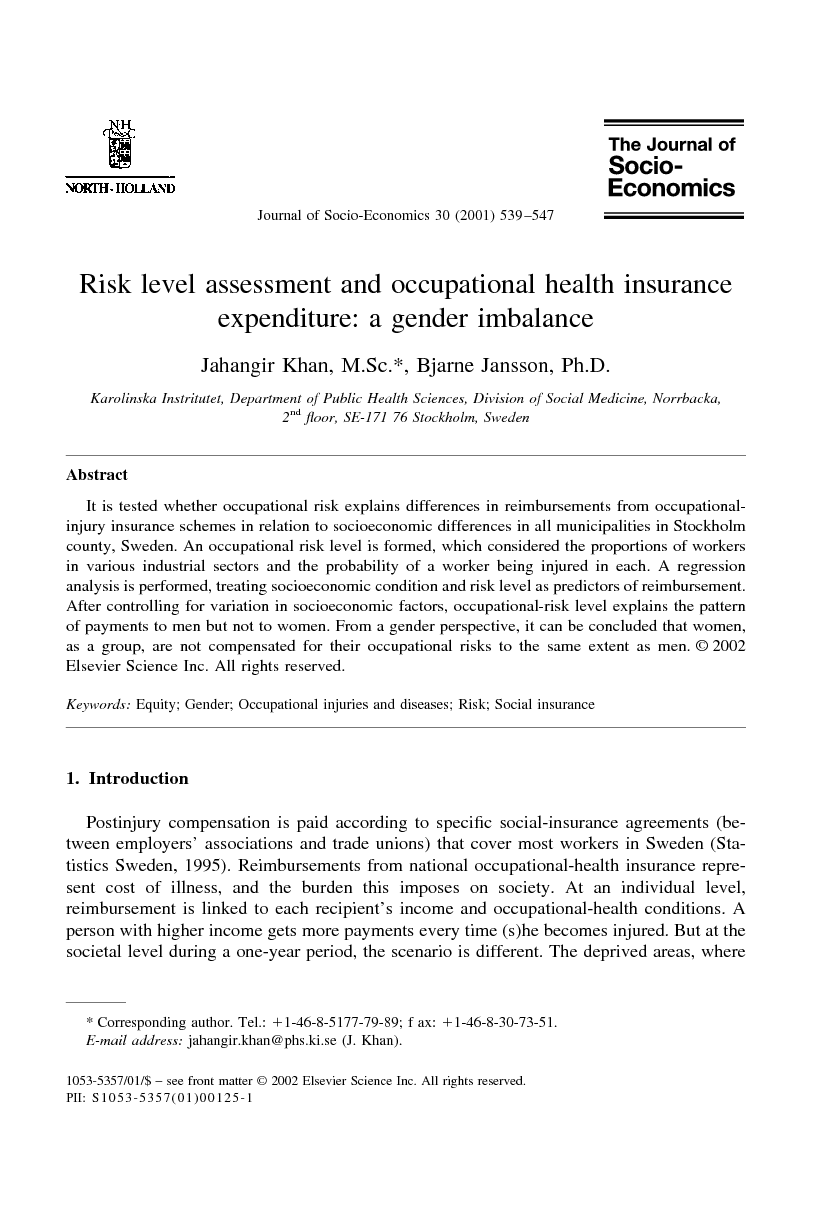It is tested whether occupational risk explains differences in reimbursements from occupational-injury insurance schemes in relation to socioeconomic differences in all municipalities in Stockholm county, Sweden. An occupational risk level is formed, which considered the proportions of workers in various industrial sectors and the probability of a worker being injured in each. A regression analysis is performed, treating socioeconomic condition and risk level as predictors of reimbursement. After controlling for variation in socioeconomic factors, occupational-risk level explains the pattern of payments to men but not to women. From a gender perspective, it can be concluded that women, as a group, are not compensated for their occupational risks to the same extent as men.
Postinjury compensation is paid according to specific social-insurance agreements (between employers’ associations and trade unions) that cover most workers in Sweden (Statistics Sweden, 1995). Reimbursements from national occupational-health insurance represent cost of illness, and the burden this imposes on society. At an individual level, reimbursement is linked to each recipient’s income and occupational-health conditions. A person with higher income gets more payments every time (s)he becomes injured. But at the societal level during a one-year period, the scenario is different. The deprived areas, where the number of low-income persons is higher (Table 1), are supposed to receive more payments in total than affluent areas with higher number of persons with high-income. The reason is that the persons with low income get injured more often. Thus, both at a point of time and a one-year period, incidences of injury is higher in a deprived area than in an affluent area.The aim of this study is, therefore, to analyze the effect of socioeconomic conditions and occupational risk involved on reimbursements from occupational-injury insurance to workers in different industrial sectors in the municipalities of Stockholm in Sweden. The hypotheses intend to test for both male and female workers if there is a socioeconomic difference in reimbursement payments and if occupational risk explains differences in reimbursements from the occupational-injury insurance scheme. Finally, we will test if occupational injury risk explains the reimbursements to male and female workers for given socioeconomic condition.
In this study, socioeconomic condition and occupational risk levels of the municipalities are estimated independently. The socioeconomic condition is assessed on the basis of all inhabitants, while occupational risk levels solely involve the working population. A socioeconomic difference in occupational risk is found in the analysis. Consequently, reimbursements from occupational-injury insurance also explain the socioeconomic difference. Occupational-injury risk also explains differences in reimbursements, and also gender differences. The adjusted correlation coefficient for the male model is 62.4, while that for the female model is only 27.4. One of the most interesting questions posed is whether occupational-risk level is still powerful enough to explain the distribution of reimbursements to male workers after controlling for socioeconomic variation. Reimbursements to male workers are explained well by risk in the workplace, but not those to female workers.
The two main findings are that there is socioeconomic variation in reimbursements and that there is an inconsistency between payments made to men and women. Concentration of workers in hazardous jobs contributes to the accumulation of occupational risk as well as to social deprivation in some geographic areas. Restructuring of occupational composition in municipalities, so that there is greater evenness across occupations would lead to greater equality in reimbursements by municipality. However, it is not only occupational structure that determines the pattern of reimbursements. Socioeconomic factors, which may be influenced by governmental intervention, are also important. Socioeconomic inequality may also have some influence on occupational hazards in the workplace. Psychosocial stress from relative deprivation, disrupted social cohesion, insufficient investment in social capital and underinvestment in human resources have all been suggested as factors involved in ill-health at population level (Chiang, 1999).
Women are represented in almost equal numbers as men on the labor market in Stockholm. However, women work fewer hours Inregia 1995 and Statistic Sweden 1994. Women suffer more from occupational diseases, whereas men have more occupational injuries (Statistics Sweden, 1995). Difference in applicability of regulation to judge the injury cases, i.e., between diseases and accidents, may explain the difference in reimbursements between women and men. Job segregation also contributes to the differential between the genders. Amount of reimbursement is directly related to level of income and prevalence of occupational hazards. Since women work fewer hours, their income level is much lower than that of men. In Stockholm county the income of men is 23% higher than that of women (Inregia, 1996). The proportion of women is higher in lower income groups, and decreases as income rises. This income effect can result in lower reimbursements to women. However, this is reflected in the analysis by controlling for socioeconomic conditions. One reason for the gender differential with regard to reimbursements is that occupational-health insurance is established on the basis of full-time employment. Accordingly, part-time workers, who are more likely to be female, will receive less compensation because of their lower income. This means that the level of risk for a full-time worker is better reflected in his/her reimbursements than that of a part-time worker. It might be argued that the probability of injury is higher for a full-time worker than for a part-time worker. When female workers are exposed to equal hazards as male at work, women, due to lower income are not fully compensated according to their occupational risk.SNI 92 1994


